Let me tell you from my own experience: two methods!
The first one:
Only three 10 times can make 10 million
Let's start with a basic theorem: In a person's lifetime, you only need to spend three ten-fold coins in a row to achieve a flat
The first step is to prepare 10,000 yuan.
10,000-100,000
100,000-1 million
1 million to 10 million
Break down 10 million into three 10-fold amounts, look for opportunities of corresponding magnitude in the first, second, and third 10-fold amounts, and repeat the money-making operation 100 times in each 10-fold amount, and you can basically get 10 million.
Of course, this is also applicable to earning 1 million or even 100 million. The underlying methodology is the same.
So your next task is to find 3 10x coins.
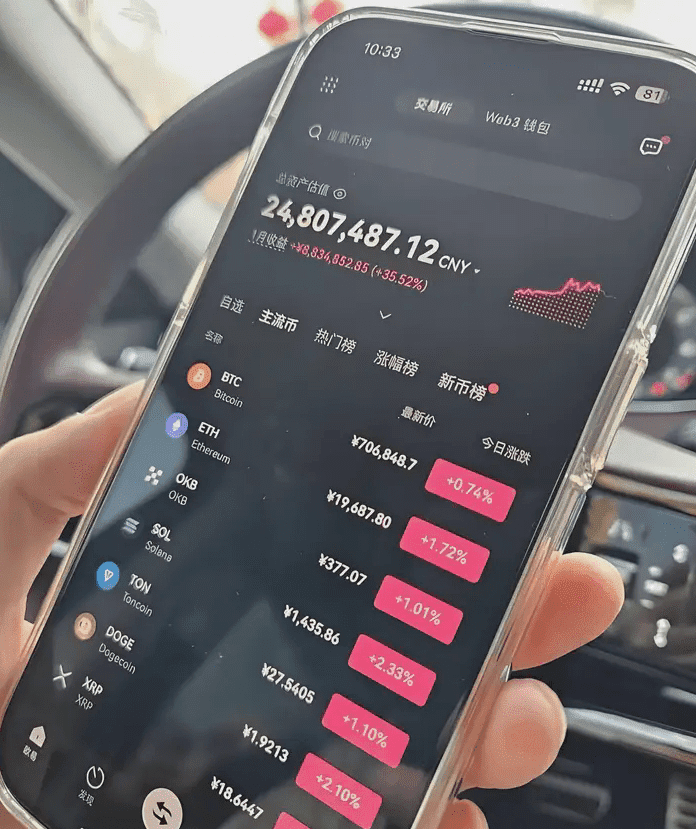
The second type:
In the cryptocurrency world, if you want to earn 1 million yuan in principal first, there is only one way to earn 1 million yuan in principal from tens of thousands of yuan, and that is rolling position.
1. In the cryptocurrency world, rolling positions usually utilize spot or contract markets to amplify profits by increasing positions.
The cryptocurrency trading community has created many legendary stories
For example, the cryptocurrency demigod "Ban Muxia" quickly made 4 million yuan with a low-risk trading strategy from a 10,000 yuan capital. "Fat House Bitcoin": A trading strategy that made him 200 million yuan from over 1 million yuan in 3 years. Their success all involves a trading strategy - rolling positions.
Rolling operation steps
1. Choose a target: Pick a cryptocurrency that you believe will have a bullish trend in the future.
2. First Buy: Use all your funds to buy the cryptocurrency.
3. Set a stop loss: Set a stop loss below the buy price to limit your losses.
4. Monitor the market: Continuously monitor market trends.
5. When the price rises: If the price rises to the preset target, use part of the profit to increase the position and buy more.
6. Repeat steps 4 and 5, continue to monitor the market, and add to your position as the price rises.
Many people believe that rolling positions carries high risks, but compared to opening futures orders, the risks are actually more controllable.
The following will be taught from a practical perspective
2. Understanding Rolling through Case Studies
Bitcoin's 2020-2021 bull market review. From October 2020 to March 2021, Bitcoin rose from $10,000 to $60,000. Let's take this period as an example to review how rolling positions can help funds grow rapidly.
This is a unilateral upward trend in a bull market. We will review the rolling operations during this period and focus on how to effectively roll positions to achieve rapid compound growth of funds.
First entry (Figure 1)
Coming to the K-line at the arrow position in the figure below, we can see that after a period of medium- to long-term fluctuations, Bitcoin has formed a converging triangle structure. At this position, a large Yang line broke through the upper downward trend line, giving us a bullish signal.
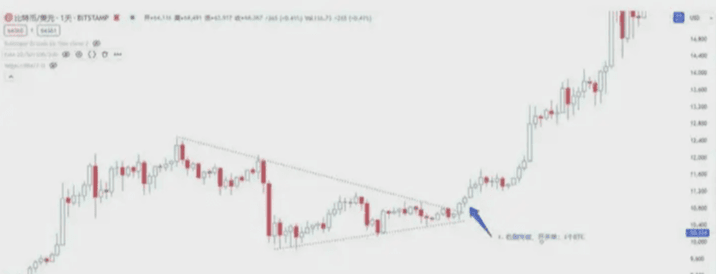
The big white candlestick on the right side of the converging triangle breaks through, sending a bullish signal
Therefore, at the position indicated by arrow 1, when BTC sends a bullish signal on the right, we can track the breakthrough on the right. Suppose we open a long order for BTC at this time.
Second entry (Figure 2)
The market then entered a very strong upward trend. At the position where the mouse is pointing, you can see that Bitcoin has formed an ascending triangle convergence pattern.
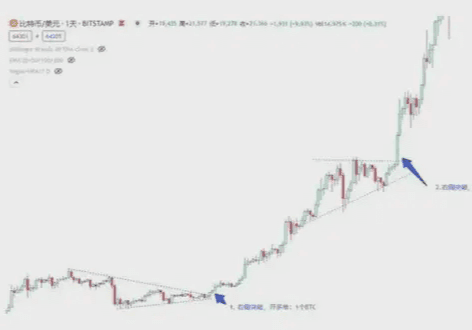
(Figure 3) This position is exactly what the fat otaku defines as the right time, or the time to roll over, as indicated by arrow 2. If we pursue a breakout to the right at this point and open a long BTC position, we can see that after several mid- to long-term fluctuations, Bitcoin breaks through its previous high with a large bullish candlestick. This position aligns with the three key principles of fat otaku trading: trading to the right, pursuing breakouts, and adding to unrealized profits.
In addition, at the convergent triangle formed at the position indicated by arrow 2, there is also a position for increasing the position, which is where arrow 3 points.
We can consider this as the support point of the rising trend line. At this point, according to the strategy defined by the fat house, it is feasible to increase positions during a pullback. When the price falls near the rising trend line and closes with a small real body candlestick, followed by a large bullish candlestick, this is also an opportunity to increase positions and also a process of rolling positions.
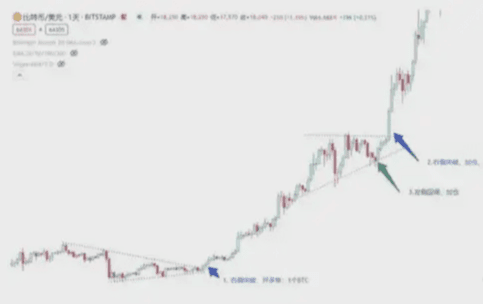
(Figure 4) It's important to note that arrow 3 represents a relatively left-side trade. Left-side trades carry greater risk, but offer a better profit-loss ratio. Compared to the first position, the second position represents a floating profit increase (also known as a rollover). As can be seen, the market then experienced a period of strong upward movement. By January 2021, the price of Bitcoin reached approximately $40,000, followed by a significant pullback and another convergent triangle formation.
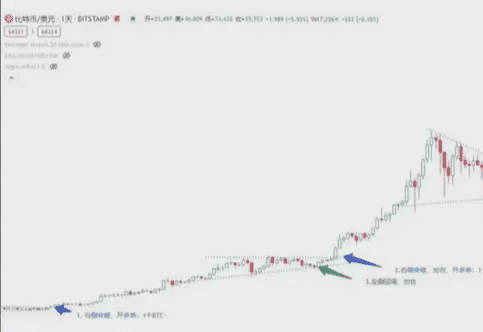
3. (Figure 1) Let’s review our first two entries. Assume that our K-line has evolved to the position before the big pullback, and the price is about 40518. At this point, we can see that the increase in the floating profit at point 2 (rolling position) is 101%.
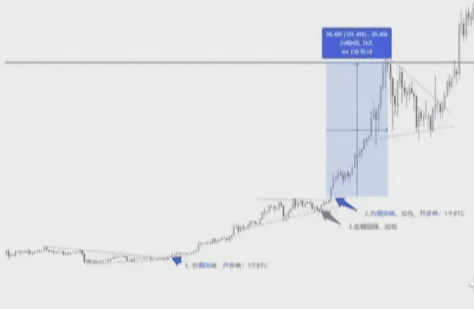
(Figure 2) If the long position at point 1 is held until this point, the increase is 261%.
After completing the rollover operation, the long position at point 2 has already benefited from the subsequent main upward trend. When the price reaches a stage of resistance, this position can be quickly reduced. In other words, the BTC long position at point 2 can be directly closed at the retracement position of 40518.
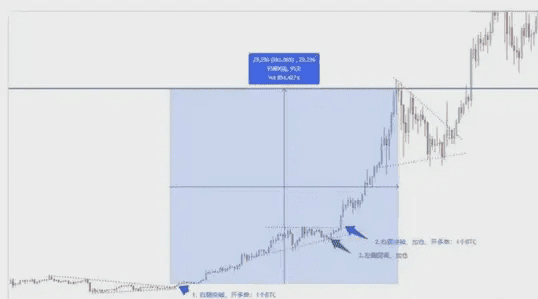
4. The third opportunity to increase your holdings
If we look at the price of 40518, we will find that there are also opportunities for rolling positions. As shown in the figure below, point 4 is a position for chasing the breakthrough on the right side, which is suitable for rolling positions. Similarly, point 5 is a position for adding positions on the left side of the callback (similar to the previous point 3, adding positions on the left side has a better profit and loss ratio).
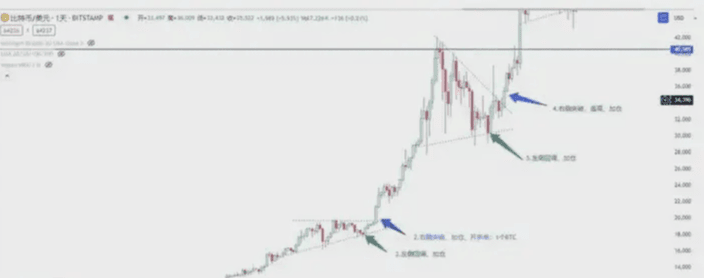
The rolling operation of the left-side trading strategy at points 3 and 5 will test the trader's technical level even more. When buying at the low point or moving average, more indicators or strategy signals must be combined to serve as the basis for the transaction.
For example, we can open a daily medium-term moving average (MA30). At the arrow 3 position, we can see that it is at the support level of the first oscillating triangle. At the same time, a positive candlestick has been formed and it is above the daily MA30. Therefore, this position can be used as a basis for judgment.
For example, at arrow 5, if we open the Fibonacci retracement of the previous uptrend, we can see that the candlestick low at 5 has essentially retraced back to the 0.5 level of the previous uptrend. This means that once the uptrend is established, secondary retracements to 0.5, or even the extreme 0.618, are crucial. After a bullish candlestick closes at this point, arrow 5 can also be a suitable position for rolling positions.
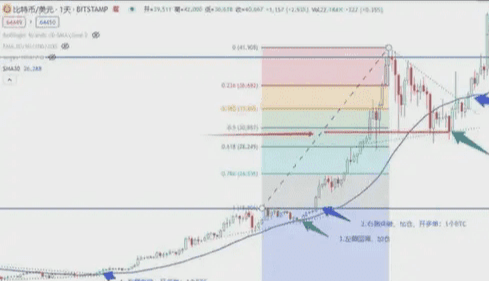
Next, at position 6, we can see a large bullish candlestick breaking through the previous high, which is a suitable position for rolling positions.
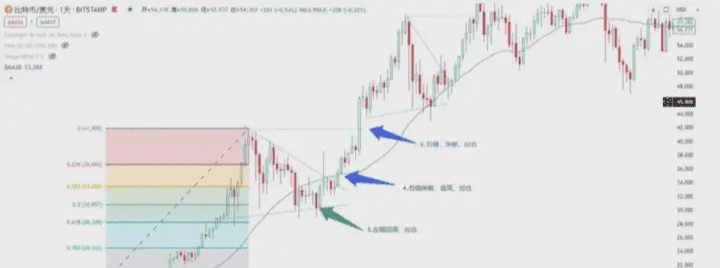
Then, the market came to position 7
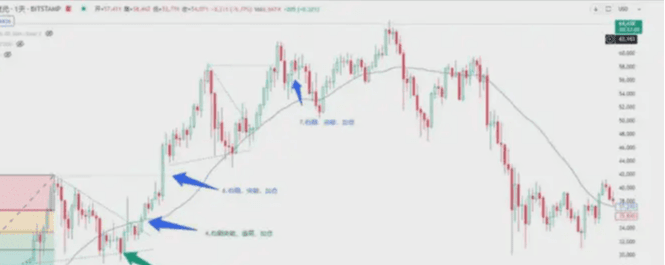
On this day, a large bullish candlestick broke through the previous high. Therefore, at position 7, we can use it as the basis for the right side transaction to perform a rolling position operation.
After the long white candlestick closes, chasing the breakout is a reasonable option. However, as we'll see later, the breakout at position 7 was actually a false breakout. If you roll your position at position 7, subsequent signals indicate a failure. Even if another high is formed after position 7 and a breakout occurs, but then it falls again, this is also a false breakout.
Therefore, if we roll over at position 7 and subsequent signals, the rollover operation will fail.
5. Suppose you only have 50,000 yuan on hand, how do you use this money to start your own investment journey?
First of all, this 50,000 should be your profit. If you are still losing money, don’t rush to read on.
Imagine you buy Bitcoin at 10,000 yuan, set a 10x leverage, and use fixed-margin trading, opening only 10% of your position, or 5,000 yuan as margin. This is equivalent to using 1x leverage and a 2% stop-loss. Even if your stop-loss is triggered, you'll only lose 2%, or 1,000 yuan. How do those people who get liquidated actually end up liquidating? Even if you do, wouldn't you only lose 5,000 yuan? How could you possibly lose everything?
If you guessed right and Bitcoin rose to $11,000, you would open a 10% position and set a 2% stop loss. Even if the stop loss was triggered, you would still earn 8%.
What about the risk? Isn't it said to be very risky?
According to this logic...
If Bitcoin rises to $15,000, and you keep adding to your position, capturing this 50% surge, you should be able to earn around $200,000. If you catch two such rallies, your account could grow to around $1,000,000. Compounding isn't necessary. A 100x increase is achieved through two 10x gains, three 5x gains, and four 3x gains, not through daily or monthly compounding of 10% or 20%. That's nonsense. Rolling isn't suitable for all cryptocurrencies. Choosing cryptocurrencies with good liquidity and active trading can reduce risk. Avoid over-accumulating, as this can easily lead to a margin call. Setting stop-loss and take-profit points can help you control risk and lock in profits.
Stay calm during market fluctuations and avoid making impulsive decisions. If the market is volatile, rolling over is not suitable, as it is easy to be swayed by emotions and make wrong decisions.
6. How to avoid risks when rolling positions
The previous increase in position was smooth, but in reality it may not be so smooth. Let’s look back at the first two transactions.
1. Initial entry: At position 1, we chased the price on the right side and opened a BTC long order. 2. Increase position: At position 2, we also increased our position and rolled it when the price broke through on the right side, and opened another BTC long order.
After completing the trades at positions 1 and 2, our average cost has moved up, now roughly between positions 1 and 2. We can see that the market did indeed enter an upward trend after breaking through position 2. However, after adding to our position at position 2, the market could have reversed instead of continued upward movement. This is entirely plausible, as we cannot accurately predict market trends.
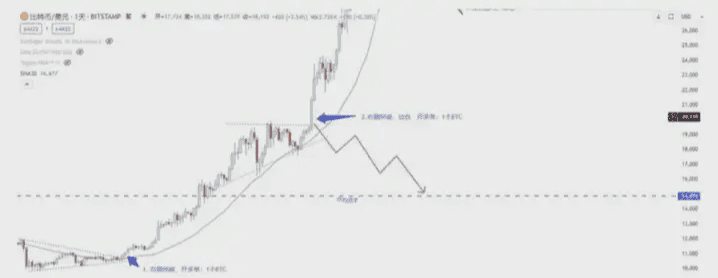
When this happens, we will experience a profit drawdown. The original transaction at position 1 was profitable, but after adding to the position at position 2, the risk increased, resulting in a profit drawdown when the price fell. Once the price fell below the average cost of our two transactions, the profit drawdown will turn into a loss trailing stop loss.
Through the rolling operation, while we release profits, our risks also increase. In order to control the risk after the rolling operation, it is necessary to use a trailing stop-loss to control the risk. New traders can refer to volatility indicators such as ATR (Average True Range), while experienced traders can use technical indicators, price behavior, etc. to find favorable stop-loss points.
For example, after rolling at position 2, we can set the stop loss of the new position below the trailing stop-loss curve associated with the ATR volatility indicator.
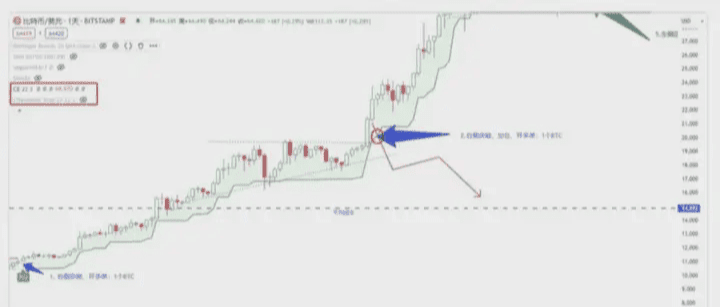
The specific operation is: open a BTC long order at position 2. If it is a false breakout, that is, a breakout followed by a decline, we can reduce this newly added position according to the price given by the trailing stop-loss and take-profit curve. This way, even if the rollover fails, we can at least reduce this newly added position first to reduce losses.
7. Disadvantages of Rolling Positions
Through the simple examples above, I think everyone should understand the definition of rolling, which is to increase positions based on profits, as well as the positions suitable for rolling, such as the breakthrough point of the secondary pullback or the low point of the secondary pullback.
Some people may think that rolling over is so simple, and making money is too easy.
This isn't actually the case. We're just using a simple example to illustrate the concept. Rolling requires a very high level of skill on the trader's part. Rolling is only suitable in a unilateral trending market, when the price continues to rise after adding to a position and then continues to rise after a correction.
In fact, 90% of the market conditions are volatile. In such conditions, if you keep adding to your position, you will only keep losing money. For example, if you roll your position during a volatile market, the result will be continuous losses. If you rolled your position during the volatile market of the past four months, you would also keep losing money. Unless you have a lot of capital, you will lose it all.
Therefore, rolling positions are only suitable for the approximately 10% of unilateral trending markets. Furthermore, rolling positions must be combined with very strict and scientific trailing stop-loss orders, otherwise the overall risk will be very high.
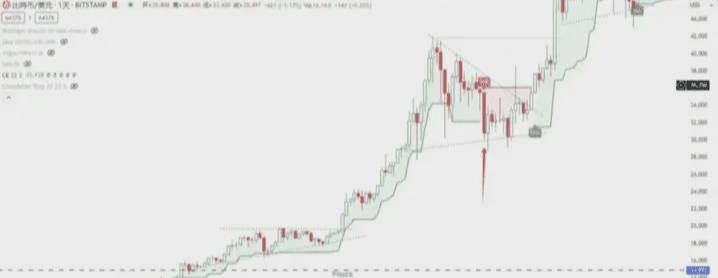
After the stop loss on the transaction on 2021-01-20, Fat House chose to stop trading. Looking back, his withdrawal and exit was very wise and intelligent. This is the operating style of Fat House: there is no particularly amazing operation, but it is such a system that can bring huge long-term benefits.

Summarize the transaction records of fat otaku rolling positions
However, judging from the overall trading record of Fat House, his overall winning rate is very low. There are three reasons for this:
1. Breakout Trading: Fat Otaku specializes in breakout trading, and while most breakouts fail, he still pursues them because the loss on a failed breakout is minimal, perhaps only 1% to 2% of his capital. However, if a breakout succeeds, his account could double or even more, resulting in a very high profit-to-loss ratio, potentially reaching dozens of times. Even with a high probability of failure, this profit-to-loss ratio keeps him willing to try.
2. Focus on Big Trends: The fat otaku only capitalizes on big trends, often refusing to exit even after making a healthy profit. His goal is to capture big trends, which results in a lower win rate. If he focused on capturing smaller trends, his win rate would be much higher, but he wouldn't achieve the same results. He accepts the lower win rate because his goal is the large gains that big trends can bring.
3. Don't miss out: A short seller doesn't want to miss out on any major trend. Without missing out, he keeps trying, entering the market as soon as a breakout signal appears. Only in this way can he ensure that once a trend begins, he will be in the market and seize the profits brought by the major trend.
Fat Otaku's trading method emphasizes risk control, insisting on breakout trading, focusing on major trends, and constantly trying to ensure that every potential major trend is captured. Although his win rate is low, his high profit-loss ratio and clear strategy have enabled him to achieve extraordinary returns in the long run.
8. Rolling and Pyramiding
If you are interested in rolling positions, then you must also understand pyramid increasing. Pyramid increasing and rolling positions are both common strategies in trading. You can understand it as "pyramid increasing is a conservative rolling". They have many similarities: > Trend following: Both increase positions when the market trend is obvious, and take advantage of the profit opportunities brought by the trend > Gradual increase in positions: Neither fills up the position all at once, but gradually increases the position according to market trends > Floating profit basis: The basis for increasing positions is on the existing floating profit, rather than covering the position when there is a loss.
The pyramid method is a technique that can increase profits exponentially. Its essence is to increase positions on the premise of profitability, and to use existing profits to gain future returns. It is an advanced trading technique.
Both it and rolling position are only suitable for strong unilateral market, which can be a rapid upward trend or a rapid downward trend. As shown in the figure below, you can clearly see the steps of pyramiding position (Figure 1)
The pyramid method of increasing holdings is a gradual and trend-following method, but it is definitely not the "diluted cost method" used by many investors. The most direct difference is:
> We will not increase our positions when we are losing money. Increasing positions against the trend is the cause of serious losses for many people, and even causes many people to "explode their positions"
> Pyramiding and rolling positions (adding to positions with floating profits) are very similar. The main difference is the increased position. In pyramiding, the added ratio becomes smaller as time goes on.
As the trend runs longer, it is more likely to encounter an unfavorable reversal trend and the psychological pressure gradually increases. It is more conservative to use the pyramid increase rule. Pyramid increase is compared with rolling position:
> Gradually reduce the amount of positions added: the total position grows slowly, and even if the market reverses, the total loss is controlled within a smaller range. > Add the same position each time: the total position grows rapidly, and a slight adverse market fluctuation may lead to large losses, which is a higher risk.
Practical Suggestions for Rolling Strategies
Rolling is a simple technique, but its high risk and high reward make it a strategy reserved for seasoned traders, particularly well-suited to unilateral trends. The core of rolling relies on position management and trend analysis, requiring the integration of sound capital management and a trailing stop-loss strategy. The following framework details the practical steps of a rolling strategy, helping you capitalize on market trends and steadily increase your position.
Basic knowledge and preparation
Basic understanding of leverage trading
While using leverage in a rolling position can magnify returns, it also carries significant risks. Therefore, it's recommended that you use leverage in isolated position mode to avoid the risk of a margin call in a full-position position. Full-position positions are extremely risky and are particularly unsuitable for rolling positions. Set trading goals.
The goal of rolling positions is to achieve compound growth through increasing positions, but this only works in one-way markets. In most markets (90% of volatile markets), rolling positions are not suitable, so we need to be patient and wait for a clear trend. Setting a goal of doubling a small amount of capital can help you stay focused, but it is more important to wait for the right moment after the trend is confirmed.
Technical Indicator Selection: To accurately identify trends, the following indicators can help you find the optimal time to roll over your positions. > Moving Average (MA): The primary tool for identifying major trends and pullbacks.
> MACD: Confirms trend strength and potential reversal signals > Converging Triangle: A common oscillating pattern that, when broken, may signal the start of a trend.
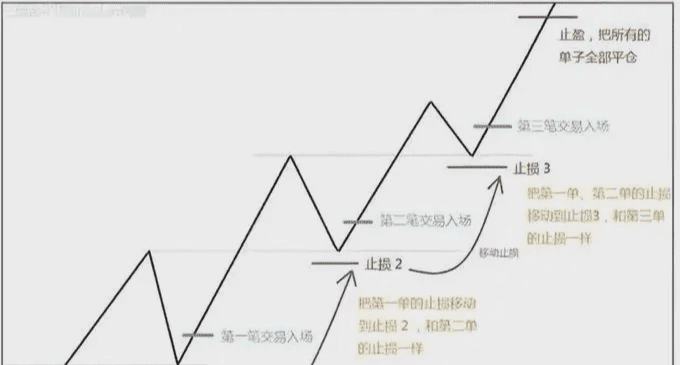

9. Core strategy of rolling position
Applicable conditions: One-sided market
The core requirement for a rolling strategy is a one-sided market, that is, a clear trend. In a volatile market, a rolling strategy can lead to frequent stop-loss orders and even losses. Therefore, you must wait for a clear trend signal, such as a breakout after a long period of sideways movement, before rolling is appropriate.
Mindset and Timing
Rolling not only tests your technical analysis skills but also your mindset. When faced with opportunities with huge profit potential, you must be patient and wait for the right moment with high certainty. Frequent rolling is not recommended. We only increase positions when there are confirmed trending opportunities, such as those that break through long-term resistance levels or after a unilateral market trend following a volatile pattern. Core logic: position management and trend analysis.
The core of rolling positions lies in position management and trend judgment.
When analyzing trends, you need to be able to distinguish between true and false breakouts, identifying when a pullback occurs and when a trend reversal occurs. This requires not only technical analysis skills but also strict money management and a trailing stop-loss strategy. After each increase in position, move the stop-loss upward to ensure that unrealized profits are not wiped out by market fluctuations. Timing of position additions and proportional rolling is crucial. Typically, increase positions with the trend after a breakout of a trend line, or against the trend when a trend pulls back to near the moving average. Each increase in capital should be arranged in a pyramid structure, with the proportion of the increase gradually decreasing as the number of increases increases to avoid excessive risk from subsequent increases.
Practical steps
Step 1: Initial Entry
Establish a position at a breakthrough point after sufficient volatility, such as a breakthrough of an important resistance level. The initial position is controlled at 10%-20% of the total capital to avoid large market fluctuations. At this time, the stop loss is usually set at 2%-3% below the key support level.
Step 2: Increase your position
When the initial position has a floating profit, you can choose to increase the position at the next callback or breakthrough point. Usually, when the price callbacks to the moving average and rebounds, or before and after a breakthrough, it can be used as a signal to increase the position. The proportion of funds added each time should not be too large. It is usually recommended that the proportion of funds added each time should not exceed 30% of the original position.
Step 3: Risk Control and Profit-Taking Strategy
Risk control is particularly important in rolling positions. With each increase in position, you need to use a trailing stop-loss, gradually moving the stop-loss level up to the previous position increase point to ensure that the floating profit is not swallowed up by market fluctuations. When a reversal signal appears, reduce or close the position in time to avoid a large drawdown.
Step 4: Accumulate Compound Interest
After each successful rollover, you can reinvest your unrealized profits into additional positions, generating compound growth. However, avoid frequent rollovers. Rollovers are best suited to medium- to long-term trends, not short-term, frequent additions. The goal of rolling is to continuously expand your position as the trend continues, maximizing returns.
Trading frequency
Rolling positions are best executed upon breakthroughs of significant resistance and support levels on the daily or weekly charts, rather than frequent short-term trading. Frequently adding to positions in volatile markets is extremely risky and can result in significant losses. The risks of adding to positions with unrealized profits. While a rolling position strategy can amplify profits, adding to positions with unrealized profits essentially increases leverage and risk. Therefore, it is recommended to adopt a pyramiding approach when adding to positions, adding smaller positions as time goes on. When profits are significant, consider gradually reducing positions rather than continuously increasing them. Funding and stop-loss management: Scientific fund management and a trailing stop-loss strategy are crucial in a rolling position strategy. Failure to adjust the stop-loss level promptly after adding to a position can turn unrealized profits into losses. Before each addition, be sure to define the specific position size and trailing stop-loss strategy in advance.
10. Frequently Asked Questions and Answers
Is rolling trading suitable for beginners?
Rolling strategies are risky, so beginners are advised to start with low-leverage, stable trend trading and then consider using rolling strategies after gaining experience.
How to determine the right time to increase your position?
The best time to add to your position is after a trend breaks through a key level, or after a pullback to a support level. Technical indicators such as moving averages, MACD, and convergence triangles can help you make these decisions.
How to operate in a volatile market?
Rolling positions are not suitable for volatile markets. When encountering volatile markets, you should reduce the frequency of operations and wait patiently for the trend to emerge.
Can I roll over my position directly when I open it?
Whether you can roll your position directly upon opening it, or wait until it's profitable before using the profit to increase your position, depends on your trading strategy and market conditions. The core concept of rolling is to continuously expand your position during a trending market, using unrealized profits to increase your position and achieve compound growth. Therefore, rolling is typically done on top of existing profits, allowing you to use existing market profits to cover the risk of new positions and reduce your personal financial exposure.
There are two common methods of rolling positions:
Open and roll positions after trend confirmation: After confirming a trend, open a position and then gradually expand it through rolling as the trend develops. This method leverages the trend to roll over unrealized profits, hoping to achieve higher returns. A typical approach involves opening a position after the market breaks through a key level and then gradually increasing the position as profits are realized. This approach carries less risk because subsequent increases are made with profitable funds.
Rolling positions immediately after opening: In some strategies, traders roll their positions immediately upon opening, often using significant leverage. This approach carries a higher risk because, without initial profits to cushion the losses, adding to positions can lead to higher losses. It's best suited for experienced traders who operate when a trend is clearly evident.
The rolling strategy described in this article tends to leverage profits to increase positions, as emphasized by Fat House Bitcoin and Master Li Tonv. This strategy leverages rising profits within a trend and uses stop-loss orders to control risk. Therefore, it's generally recommended to wait until a position has generated a certain level of profit before using a rolling strategy to mitigate risk and effectively maximize profits.
Final Tips
I would like to offer some advice to beginners or friends who want to imitate this approach.
Reduce profit-loss ratio:
It is difficult for novices to endure long periods of floating losses and constant stop losses to catch the big trend. It is very likely that they have lost everything or their mentality has collapsed before the big trend appears. Therefore, I suggest that novices lower the profit and loss ratio, but not too low. Generally speaking, the profit and loss ratio can be set at around 2 to 3 times. The specific profit and loss ratio should be adjusted according to the market conditions. If the market conditions are suitable for a 2 or 3 times profit and loss ratio, use 2 or 3 times. If the market conditions are particularly good, you can boldly try a 4 or even 5 times profit and loss ratio. Doing so can make the winning rate close to 50%, that is, between 45% and 55%, making it easier to maintain a good mentality. It is difficult for ordinary people to stick to a 20% winning rate like Fat House. If you pursue a profit and loss ratio of 10 times or even 20 times, you have to endure long periods of stop losses and floating losses.
2. Accept missing out:
Trying to capitalize on every major market move without wanting to miss out inevitably sacrifices your winning rate. New traders should accept the risk of missing out, sacrificing some market conditions to capture those with higher certainty. For example, if there are 10 market waves in a year, catching only 2 or 3 of them will yield a decent profit, and the profit curve will be smoother, with fewer stop-loss orders. Focus on market context rather than technical details: Instead of poring over technical books and videos, learn to judge the market context. Invest more effort in good markets and take a break in bad ones, focusing on the easy money. This is crucial. The fat otaku's strategy was very simple, and most of his profits came from his last two trades. If he hadn't persisted and given up early, he wouldn't have achieved such results. Therefore, it's easier to make money trading in good markets, while constantly trading in bad ones won't. For example, most people will struggle to make a profit in 2022, so it's better to take a break in bad markets and trade more frequently in good ones to earn more.
From 10,000 to 10 million in one move! This simple cryptocurrency trading method includes 10 trading tips that everyone can use.
Tips: 1. Consolidate highs and lows and then observe
When the market is consolidating at high or low levels, a more prudent strategy is to wait and see. Sideways trading often signals a change; after digesting the previous volatility, the market will ultimately choose a clear direction. At this point, rash action could lead to unnecessary losses. Waiting for market clarity before acting accordingly is the wisest approach. Veterans have repeatedly reminded us, "When the market is sideways, waiting and watching is more valuable than blindly trading."
2. Don’t be attached to hot positions; adjust your positions according to the market conditions.
In short-term operations, hot positions are often the result of speculation. Once the heat dissipates, funds will quickly leave the market, and investors who remain in it will face a passive situation. Therefore, the predecessors suggest that one should not linger on hot positions for a long time, but should adjust flexibly and always maintain mobility. As he said, "Short-term hot positions come and go quickly, and they will chase the rise and sell the fall at the slightest mistake." Successful short-term operations are by no means blindly following the trend, but always staying sober and doing "from beginning to end, in the end, nothing is left." 1's
3. The upward trend opens higher, and the position needs to be firm
If, during an uptrend, the K-line shows a gap-up, bullish candlestick pattern accompanied by high volume, it indicates the market has entered a phase of accelerated growth. During this period, it's important to remain calm and hold on firmly, as this often leads to a surge. Veterans refer to this as the "growth phase," emphasizing the importance of unwavering conviction and resistance to short-term fluctuations during this phase, in order to reap substantial profits.
4. A huge bullish candlestick requires decisive exit
Whether the market is high or low, the appearance of a large bullish candlestick is a signal to exit the market. In this case, even if the price hits the daily limit, you should decisively close your position, as in most cases, a pullback will follow a large bullish candlestick. Our predecessors taught us, "No matter how tempting the profit, closing your position decisively while you're ahead is the key to avoiding profit-taking." The core of this strategy is knowing when to advance and when to retreat. Risk must be guarded against in all circumstances, and profit drawdowns must be controlled.
5. Buy when the moving average is above the negative line and sell when the moving average is below the positive line
Moving averages are a key reference for short-term trading. If the stock price is above a key moving average and a bearish correction occurs, it's a buy signal. Conversely, a bullish candlestick below a moving average may signal a lack of upward momentum, suggesting a sell opportunity. In short-term investing, it's generally best to focus solely on the daily moving average or attack line, avoiding delays and holding positions for extended periods. A veteran investor advises, "No more than a week, sell within three days; don't miss the opportunity." Short-term trading requires speed and precision; holding for extended periods increases risk.
6. Don’t sell if the price goes up, don’t buy if the price goes down, and don’t move if the price goes sideways.
In the cryptocurrency world, where market fluctuations are frequent, this principle is considered a fundamental rule of survival. If the current price isn't significantly higher than the purchase price, don't sell rashly; conversely, if there's no significant decline, don't rush to buy. When the market is in a stagnant state, it's safer to wait and see. Veterans call this "stability first." Any rash trade can lead to losses. Long-term profitability depends not on frequent entry and exits, but on choosing the right entry and exit times.
7. It is better to take in less than more, and do what you can.
In the cryptocurrency world, flexibility is key. Even if you're extremely confident, it's best not to invest a large amount all at once. Proper position allocation is crucial. Our predecessors remind us to "better invest small than large." Market fluctuations can be unpredictable, and diversification can reduce the risk of a single investment. For each trade, maintain a reasonable position ratio to avoid being caught off guard by unexpected market fluctuations.
8. Learn to interpret market news
In the cryptocurrency world, the influence of news cannot be underestimated. Market news often directly triggers significant price fluctuations, potentially leading to sharp increases or decreases. Therefore, investors should learn to interpret market information, especially major events and policies. Veterans advise new investors to wait and see when encountering major news, as excessive intervention can lead to unnecessary losses.
9. Master technical indicator analysis
Technical analysis plays a crucial role in the cryptocurrency world. Experts recommend that beginners systematically study technical indicators, develop a learning plan, and master analytical tools such as moving averages, KDJ (K-Drawing Difference) indicators, Bollinger Bands, candlestick patterns, volume-price relationships, and capital flows. Technical analysis requires extensive experience and is not a one-time skill. However, mastering technical analysis can help investors determine buying and selling points and mitigate unnecessary losses.
10. Develop a trading plan and avoid frequent trading
Frequent trading not only incurs high fees but also disrupts trading mentality and can lead to emotional trading. Veterans emphasize that "trading requires planning, not blind, arbitrary action." In the cryptocurrency world, frequent entry and exit often means greater uncertainty. An effective trading plan can help investors maintain rationality and clarity of thought.


